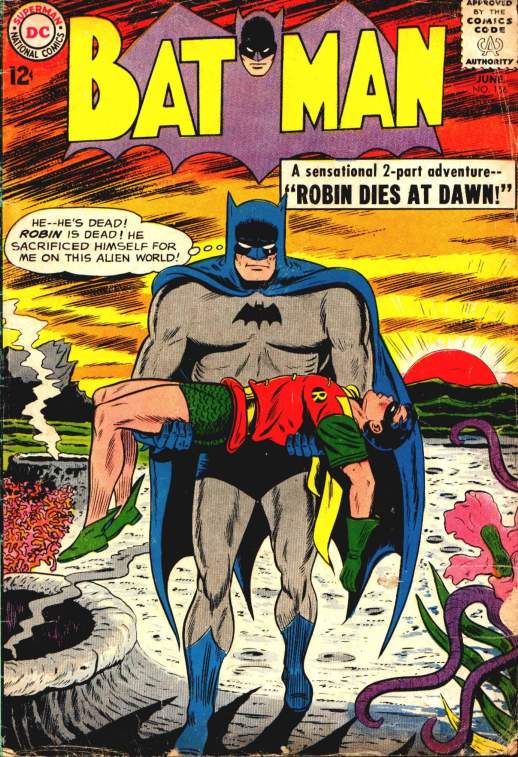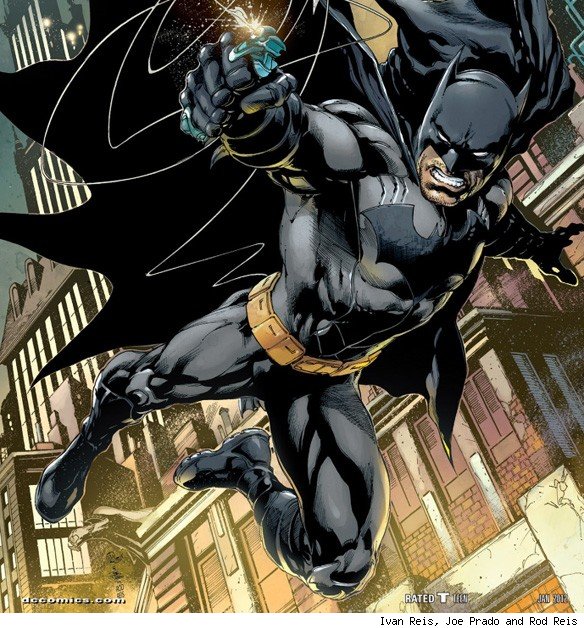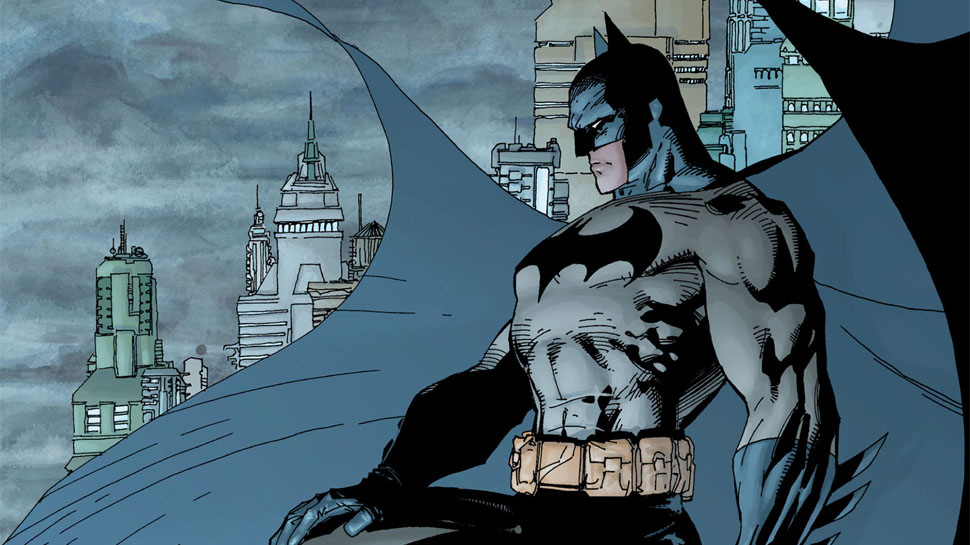Batman is the super-hero protector of Gotham City, a man dressed like a bat who fights against evil and
strikes terror into the hearts of criminals everywhere. In his secret identity, he assumes the alias of Bruce Wayne,
billionaire industrialist and notorious playboy; though "Bruce Wayne" is technically his real name, this Bruce Wayne is
a disguise--that of the man he would have been had his parents not been murdered before his eyes when he was no more than
a mere boy.
Although Batman possesses no super-human powers, he is one of the world's smartest men and greatest fighters. His physical
prowess and technical ingenuity make him an incredibly dangerous opponent. He is also a founding member of the Justice League
and the Outsiders. Dick Grayson, the first "crime orphan" to assume the identity of Robin and be nicknamed "The Boy Wonder,"
who currently uses the alias of Nightwing, is Wayne's hand-picked successor, and they operate simultaneously as part of Batman
Incorporated.
History A family outing to the cinema ended in tragedy for young Bruce Wayne. Walking homeward, Bruce, his father, Thomas, and
mother, Martha, accidentally ventured into Gotham City's notorious "Crime Alley" and were accosted by a mugger. Not content merely
to rob the wealthy family, the hoodlum - whose identity was "never determined" - shot Dr. Thomas and Martha Wayne dead before fleeing
into the darkness. As he knelt beside his parent's bodies, Bruce swore to avenge them. After the police arrived, Bruce was comforted
by Dr. Leslie THompkins. Dr. Thompkins and Alfred Pennyworth helped arrange matters so that Gotham's Social Services would not take
Bruce into care. In this way, both Dr. Thompkins and Alfred enabled Bruce to realize his dream of becoming a crusader against crime.
The Young Bruce Wayne At age 14, Bruce embarked on a journey that took him to every continent as he sought to learn all the
skills he would need to keep his vow. He studied criminology, forensics, and criminal psychology, and learned from manhunters
and martial artists, mastering every fighting style. In time, Bruce forged himself into a living weapon to wage war on crime a
nd injustice. On his return to Gotham, Bruce stalked street thugs as a plainclothes vigilante. Beaten by the very people he
intended to protect, he barely survived his first night out. As he sat bleeding in his study at Wayne Manor Bruce knew that he
had to first strike fear in the hearts of his foes. Just then, a bat crashed through the study window, giving Bruce the inspiration
he needed.
Establishing a secret headquarters in the caves beneath his mansion, Bruce became Batman, a Dark Knight to protect Gotham and
its citizens from vice and villainy. Alfred Pennyworth remained his confidant, tending to injuries and offering sage advice -
whether requested or not!Batman became an urban legend, a cautionary tale that sent shivers through the city's underworld.
This Caped Crusader found a friend in Captain James Gordon a Gotham cop who didn't approve of Batman's methods, but appreciated
the results of his nightly crime fighting. Batman's Rogues Gallery grew to include a host of bizarre criminals, such as the Joker,
Catwoman, Two-Face and the Penguin. As his enemies increased, help arrived in the form of another young boy left parentless by brutal
crime.
 Golden Age:
In the first version during the Golden Age, Batman's first appearance in Detective Comics #27, he is already operating as a crime
fighter. Batman's origin is first presented in Detective Comics #33 (Nov. 1939), and is later fleshed out in Batman #47. As these
comics state, Bruce Wayne is born to Dr. Thomas Wayne and his wife Martha, two very wealthy and charitable Gotham City socialites in 1
915. Bruce is brought up in Wayne Manor, with it's wealthy splendor, and lives a happy and privileged existence until the age of
eight, when his parents are killed by a small-timed criminal named Joe Chill while on their way home from a movie theater. Bruce Wayne
swears an oath to rid the city of the evil that had taken his parents' lives. He engages in intense intellectual and physical training;
however, he realizes that these skills alone would not be enough. "Criminals are superstitious and cowardly lot," Wayne remarks,
"so my disguise must be able to strike terror into their hearts. I must be a creature of the night, black, terrible..."
As if responding to his desires, a bat suddenly flies through the window, inspiring Bruce to take on the persona of Batman.
In early strips, Batman's career as a vigilante earns him the ire of the police. During this period, Wayne has a fiancee named
Julie Madison. Wayne takes in an orphaned circus acrobat, Dick Grayson, who becomes his sidekick, Robin. Batman also becomes a
founding member of the Justice Society of America, although he, like Superman, is an honorary member, and thus only participates
occasionally. Batman's relationship with the law thaws quickly, and he is made an honorary member of Gotham City's police department.
During this time, butler Alfred Pennyworth arrives at Wayne Manor, and after deducing the Dynamic Duo's secret identities joins their
service.
Golden Age:
In the first version during the Golden Age, Batman's first appearance in Detective Comics #27, he is already operating as a crime
fighter. Batman's origin is first presented in Detective Comics #33 (Nov. 1939), and is later fleshed out in Batman #47. As these
comics state, Bruce Wayne is born to Dr. Thomas Wayne and his wife Martha, two very wealthy and charitable Gotham City socialites in 1
915. Bruce is brought up in Wayne Manor, with it's wealthy splendor, and lives a happy and privileged existence until the age of
eight, when his parents are killed by a small-timed criminal named Joe Chill while on their way home from a movie theater. Bruce Wayne
swears an oath to rid the city of the evil that had taken his parents' lives. He engages in intense intellectual and physical training;
however, he realizes that these skills alone would not be enough. "Criminals are superstitious and cowardly lot," Wayne remarks,
"so my disguise must be able to strike terror into their hearts. I must be a creature of the night, black, terrible..."
As if responding to his desires, a bat suddenly flies through the window, inspiring Bruce to take on the persona of Batman.
In early strips, Batman's career as a vigilante earns him the ire of the police. During this period, Wayne has a fiancee named
Julie Madison. Wayne takes in an orphaned circus acrobat, Dick Grayson, who becomes his sidekick, Robin. Batman also becomes a
founding member of the Justice Society of America, although he, like Superman, is an honorary member, and thus only participates
occasionally. Batman's relationship with the law thaws quickly, and he is made an honorary member of Gotham City's police department.
During this time, butler Alfred Pennyworth arrives at Wayne Manor, and after deducing the Dynamic Duo's secret identities joins their
service.
 Silver Age:
The story was completely changed during the Silver Age, when it was sometimes held to have begun in 1956 when the publisher introduced
Barry Allen as a new, updated version of The Flash. Batman is not significantly changed by the late 1950s for the continuity which
would be later referred to as Earth-One. The lighter tone Batman had taken in the period between the Golden and Silver Ages led to
the stories of the late 1950s and early 1960s that often feature a large number of science-fiction elements, and Batman is not
significantly updated in the manner of other characters until Detective Comics #327 (May 1964), in which Batman reverts to his
detective roots, with most science-fiction elements jettisoned from the series. After the introduction of DC Comics'
multiverse in the 1960s, DC established that stories from the Golden Age star the Earth-Two Batman, a character from a parallel
world. This version of Batman partners with and marries the reformed Earth-Two Catwoman, Selina Kyle (as shown in Superman Family #211)
and fathers Helena Wayne, who, as the Huntress, becomes (along with Dick Grayson, the Earth-Two Robin) Gotham's protector once Wayne
retires from the position to become police commissioner, a position he occupies until he is killed during one final adventure as
Batman. Batman titles however often ignored that a distinction had been made between the pre-revamp and post-revamp Batmen (
since unlike The Flash or Green Lantern, Batman comics had been published without interruption through the 1950s) and would on
occasion ake reference to stories from the Golden Age. Nevertheless, details of Batman's history were altered or expanded upon
through the decades. Additions include meetings with a future Superman during his youth, his upbringing by his uncle Philip Wayne
(introduced in Batman #208, January/February 1969) after his parents' death, and appearances of his father and himself as prototypical
versions of Batman and Robin, respectively. In 1980, then-editor Paul Levitz commissioned the Untold Legend of the Batman limited
series to thoroughly chronicle Batman's origin and history. Batman meets and regularly works with other heroes during the Silver Age,
most notably Superman, whom he began regularly working alongside in a series of team-ups in World's Finest Comics, starting in 1954
and continuing through the series' cancellation in 1986. Batman and Superman are usually depicted as close friends. Batman becomes a
founding member of the Justice League of America, appearing in it's first story in 1960s Brave and the Bold #28. In the 1970s and
1980s, Brave and the Bold became a Batman title, in which Batman teams up with a different DC Universe superhero each month.
Silver Age:
The story was completely changed during the Silver Age, when it was sometimes held to have begun in 1956 when the publisher introduced
Barry Allen as a new, updated version of The Flash. Batman is not significantly changed by the late 1950s for the continuity which
would be later referred to as Earth-One. The lighter tone Batman had taken in the period between the Golden and Silver Ages led to
the stories of the late 1950s and early 1960s that often feature a large number of science-fiction elements, and Batman is not
significantly updated in the manner of other characters until Detective Comics #327 (May 1964), in which Batman reverts to his
detective roots, with most science-fiction elements jettisoned from the series. After the introduction of DC Comics'
multiverse in the 1960s, DC established that stories from the Golden Age star the Earth-Two Batman, a character from a parallel
world. This version of Batman partners with and marries the reformed Earth-Two Catwoman, Selina Kyle (as shown in Superman Family #211)
and fathers Helena Wayne, who, as the Huntress, becomes (along with Dick Grayson, the Earth-Two Robin) Gotham's protector once Wayne
retires from the position to become police commissioner, a position he occupies until he is killed during one final adventure as
Batman. Batman titles however often ignored that a distinction had been made between the pre-revamp and post-revamp Batmen (
since unlike The Flash or Green Lantern, Batman comics had been published without interruption through the 1950s) and would on
occasion ake reference to stories from the Golden Age. Nevertheless, details of Batman's history were altered or expanded upon
through the decades. Additions include meetings with a future Superman during his youth, his upbringing by his uncle Philip Wayne
(introduced in Batman #208, January/February 1969) after his parents' death, and appearances of his father and himself as prototypical
versions of Batman and Robin, respectively. In 1980, then-editor Paul Levitz commissioned the Untold Legend of the Batman limited
series to thoroughly chronicle Batman's origin and history. Batman meets and regularly works with other heroes during the Silver Age,
most notably Superman, whom he began regularly working alongside in a series of team-ups in World's Finest Comics, starting in 1954
and continuing through the series' cancellation in 1986. Batman and Superman are usually depicted as close friends. Batman becomes a
founding member of the Justice League of America, appearing in it's first story in 1960s Brave and the Bold #28. In the 1970s and
1980s, Brave and the Bold became a Batman title, in which Batman teams up with a different DC Universe superhero each month.
 Post-Crisis:
The Crisis on Infinite Earths ended the Multiverse and streamlined the DC Universe into a new continuity. After the 12-issue
limited series Crisis on Infinite Earths, DC Comics retconned the histories of some major characters in an attempt at updating
them for contemporary audiences. Frank Miller retold Batman's origin in the storyline, "Year One" from Batman #404-407, which
emphasizes a grittier tone in the character. Though the Earth-Two Batman is erased from history, many stories of Batman's Silver
Age/Earth-One career (along with an amount of Golden Age ones) remain canonical in the post-Crisis universe, with his origins
remaining the same in essence, despite alteration. For example, Gotham's police are mostly corrupt, setting up further need
for Batman's existence. While Dick Grayson's past remains much the same, the history of Jason Todd, the second Robin, is altered,
turning the boy into the orphan son of a petty crook, who tries to steal the tires from the Batmobile. Also removed is the guardian
Philip Wayne leaving young Bruce to be raised by Alfred Pennyworth. Additionally, Batman is no longer a founding member of the Justice
League of America (until the events of Infinite Crisis, he is known to be again), although he becomes leader for a short time of a new
incarnation of the team launched in 1987. To help fill in the revised backstory for Batman following Crisis, DC launched new Batman titles
called Legends of the Dark Knight in 1989 and Batman Confidential in 2006 and has published various miniseries and one-shot stories since
then that largely take place during the "Year One" period. Various stories from Jeph Loeb and Matt Wagner also touch upon this era.
Post-Crisis:
The Crisis on Infinite Earths ended the Multiverse and streamlined the DC Universe into a new continuity. After the 12-issue
limited series Crisis on Infinite Earths, DC Comics retconned the histories of some major characters in an attempt at updating
them for contemporary audiences. Frank Miller retold Batman's origin in the storyline, "Year One" from Batman #404-407, which
emphasizes a grittier tone in the character. Though the Earth-Two Batman is erased from history, many stories of Batman's Silver
Age/Earth-One career (along with an amount of Golden Age ones) remain canonical in the post-Crisis universe, with his origins
remaining the same in essence, despite alteration. For example, Gotham's police are mostly corrupt, setting up further need
for Batman's existence. While Dick Grayson's past remains much the same, the history of Jason Todd, the second Robin, is altered,
turning the boy into the orphan son of a petty crook, who tries to steal the tires from the Batmobile. Also removed is the guardian
Philip Wayne leaving young Bruce to be raised by Alfred Pennyworth. Additionally, Batman is no longer a founding member of the Justice
League of America (until the events of Infinite Crisis, he is known to be again), although he becomes leader for a short time of a new
incarnation of the team launched in 1987. To help fill in the revised backstory for Batman following Crisis, DC launched new Batman titles
called Legends of the Dark Knight in 1989 and Batman Confidential in 2006 and has published various miniseries and one-shot stories since
then that largely take place during the "Year One" period. Various stories from Jeph Loeb and Matt Wagner also touch upon this era.

